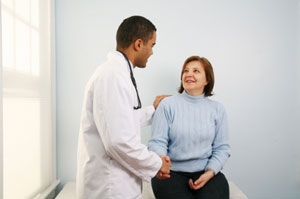'Red Flags' - Symptoms to Look Out for!
WARNING: If you have any of the following serious symptoms, please contact your doctor or healthcare provider immediately
 There are a number of Red Flag Signs (serious warning signs), which may lead your Healthcare Practitioner to arrange rapid investigations and treatment.
There are a number of Red Flag Signs (serious warning signs), which may lead your Healthcare Practitioner to arrange rapid investigations and treatment.
The Red Flag Signs may indicate a serious underlying problem of the spine.
If any of these applies to you, you should see your GP, Hospital Specialist or Healthcare Practitioner soon.
‘Red Flags’ : Spinal Pain
- The pain is in the upper part of the spine (thoracic spine).
- You have developed problems in the nervous system, for example numbness, loss of power, disturbed walking (gait) or bowel/ bladder disturbance.
- You have had cancer in the past or at present.
- The pain is constant and getting worse.
- The pain follows a violent injury, such as an RTA (road traffic accident).
- You are on steroid medication.
- You are misusing drugs, or have HIV.
- You are generally unwell in yourself or have an unexplained fever.
- You have lost a significant amount of weight.
- You are continuing to have great difficulty bending forwards.
- If you are younger than 20 or older than 55 when you get back pain for the first time.
- You have developed a structural deformity of the spine.
- You should also see your doctor (either for a first visit, or for a follow-up) if the pain is continuing for more than 4-6 weeks.
WARNING: If you have any of the above serious symptoms, please contact your doctor or healthcare provider immediately
‘Red Flags’ : Lower Back Pain
Lower back pain is a very common phenomenon. It can start because of a sudden trauma such lifting something too heavy or as the result of an awkward fall. It can also seem to come out of nowhere, for no reason at all.
Sometimes this pain can be worse when sitting or bending forwards, and actions such as turning over in bed or rising from a lying to a sitting position can be worse. In some cases, sneezing or coughing could make the pain worse and even cause the muscles to spasm. It is not unusual for the back pain to be accompanied by pain down the leg.
When to Rest and When to Make an Appointment
 In most cases, this lower back pain is caused by a strain of the muscles or ligaments that are connected to the vertebrae and is called simple or mechanical pain. Often the cause of this pain will be so slight that it won’t even show up on a CT scan or MRI. This sort of pain will very often sort itself out in a matter or days or weeks.
In most cases, this lower back pain is caused by a strain of the muscles or ligaments that are connected to the vertebrae and is called simple or mechanical pain. Often the cause of this pain will be so slight that it won’t even show up on a CT scan or MRI. This sort of pain will very often sort itself out in a matter or days or weeks.
A slipped disc can also be the cause of the pain. This happens when the intervertebral discs that act as shock absorbers between the vertebrae become damaged. Either the disc itself bulges out of place or the thick, outer layer tears and allows the soft, gel-like centre to bulge through the tear.
Sometimes the disc can put pressure on the nearby nerve roots or on the spinal cord itself. A common problem is the disc putting pressure on the sciatic nerve, the largest nerve in the body and the nerve that sends messages down to the legs. The disc can sometimes sort itself out if it is a mild case.
However, there are a number of red flags that should be heeded that may signal that there is something more serious happening in the lower back. If you are suffering from lower back pain and notice any of the following red flags, you should make an appointment to see your doctor as soon as possible.
Red Flags : Spinal Pain
- You are under the age of twenty or over the age of fifty-five when the pain starts for the first time.
- The pain follows a violent injury, such as a car accident
- The pain never stops and is getting worse
- You have had in the past or are currently fighting cancer
- You are on steroid medication
- You have HIV
- You are abusing drugs, intravenously or otherwise
- You have recently lost a significant amount of weight
- You have a fever
- You have great difficulty in bending forwards
- You have had the pain for more than six weeks
- You also have pain in the upper part of the back
- You have problems with incontinence
- You are experiencing numbness or weakness in one or both legs

